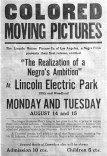|
|
 |
 |
|
Reading Guide |
| 5. |
Popular Culture
| - | Meta Warrick-Fuller, Ethiopia Awakening, sculpture, 1914 |
| - | Realization of a Negro's Ambition, film poster, 1915 |
| - | George Bellows, Both Members of This Club, oil on canvas, 1909 |
| - | William Waring Cuney, "My Lord, What a Morning," poem, n.d. |
|
|
 |
The issues faced by the NAACP in the social/political arena were mirrored in the popular culture of the time. As is always the case. For most whites, the image of the lazy simple black man was perpetuated in the minstrel shows and show tunes of the time. But for black people, the emergence of the African American image as a proud icon was apparent from the fine arts to the athletic arena, and to the new medium of moving pictures. Four example are presented here—a sculpture, a film poster, a painting, and a poem.
Two works represent the unapologetic depiction of black identity and, daringly, the act of self-definition. In 1914 Meta Warrick Fuller, creator of the "Negro Tableaux" for the 1907 Jamestown Exposition, sculpted the image of a stalwart, and self-contained black woman, reminiscent of an ancient Egyptian pharaoh, in Ethiopia Awakening. A year later, in response to the film Birth of a Nation, the black actor Noble Johnson and his brother George created the first African American-owned film studio; its first production was the provocatively titled Realization of a Negro's Ambition. Depicting the American dream of a lowly man who strikes oil and becomes a millionaire, the film was a "'Class A' Negro motion picture," Johnson wrote, "minus all burlesque and humiliating comedy.'" No copy of the film exists, but a poster for the film reveals its import at the time to black Americans.
Boxing became an avenue of social acceptance for blacks early in the century, and one venue was the athletic "clubs" [bars] which required one-day membership for the fighters, black and white. Thus the title given by white artist George Bellows to his painting Both Members of This Club, alluding to the brief equality allowed the black contender. In the painting the black man is surely ascendant, the white man near defeat. (Of a significance you can ponder, Bellows initially titled his painting A White Man and a Nigger.) The most famous boxer of the time, of course, was Jack Johnson, who defeated the "Great White Hope" Jim Jeffries in 1910 to defend the heavyweight title he had won two years earlier in Australia. Black poet Waring Cuney's brief lines, "My Lord, What a Morning," written years after the event, convey the impact of Johnson's victory for black Americans. 4 pages.
Discussion questions
- What strikes you at most “modern” about these images? How did they signal a break from the past?
- Compare the black-produced images of the 1910s with those of earlier years, such as Lewis’s Forever Free (1867), Bannister’s Newspaper Boy (1869), Tanner’s The Banjo Lesson (1895), the Du Bois photograph albums (1900), and the Americus Quartet’s cakewalk films (1900).
- Consider, too, the images portrayed in earlier black literary works, such as Uncle Julius in Chesnutt’s short stories, the "colored soldiers" in Dunbar’s poem (1895), and the slave singing a "sorrow song" as performed by the Jubilee Singers. How do these images appear from the vantage point of the 1910s?
- What precursors to the Harlem Renaissance do you see in these works?
|
» Link |
 |
 |
Topic Framing Questions
| • |
What gains and setbacks mark the period of 1907 to 1917 for black Americans? |
| • |
To what extent did African Americans set their own paths forward? |
| • |
How were the lives of ordinary black people affected by black and white leadership? |
| • |
What identity had African Americans created, as a group, between 1865 and 1917? |
| • |
What insights could black Americans take forward into the postwar years and the 1920s?
|
|
|
 |
 |
|
 |
